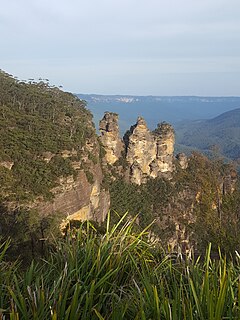Three Sisters (Australia) (original) (raw)
From Wikipedia, the free encyclopedia
Rock formation in New South Wales, Australia
| Three Sisters | |
|---|---|
| Stratigraphic range: Triassic | |
 The Three Sisters towering above the Jamison Valley. The Three Sisters towering above the Jamison Valley. |
|
| Type | Rock formation |
| Unit of | Great Dividing Range |
| Lithology | |
| Primary | Sandstone |
| Location | |
| Coordinates | 33°44′8″S 150°18′52″E / 33.73556°S 150.31444°E / -33.73556; 150.31444 |
| Region | Blue Mountains |
| Country | Australia |
| Type section | |
| Named for | Indigenous mythology |
The Three Sisters are an unusual rock formation in the Blue Mountains of New South Wales, Australia, on the north escarpment of the Jamison Valley. They are located close to the town of Katoomba and are one of the Blue Mountains' best known sites, towering above the Jamison Valley.[1] Their names are Meehni (922 m), Wimlah (918 m), and Gunnedoo (906 m).[2]
The formation receives more than 600,000 visitors per year.[3]
A view of The Three Sisters rock formation alongside Mount Solitary. The lighter coloured orange/yellow sections indicate fresh rock, exposed by recent erosion.
The Three Sisters at sunset
The Three Sisters were formed by land erosion around 200 million years ago during the Triassic period when the sandstone bog the Blue Mountains was eroded over time by wind, rain and rivers, causing the cliffs surrounding the Valley to be slowly broken up.
When the Blue Mountains were covered in seawater, the ocean carried large amounts of sediment that gradually sunk to the floor in crosswise layers. These layers later created rock beds and shales. Around 200 million years ago, volcanoes erupted through the coal, sandstone and shale layers, forming the ridges and the shape of the Three Sisters.[4]
The Three Sisters at morning
The commonly told legend of the Three Sisters is that three sisters, Wimalah, Meeni, and Gunedoo,[5] lived in the Jamison Valley as members of the Katoomba tribe. They fell in love with three men from the neighbouring Nepean tribe, but marriage was forbidden by tribal law. The brothers were not happy to accept this law and so decided to capture the three sisters. A major tribal battle ensued, and the sisters were turned to stone by an elder to protect them, but he was killed in the fighting and no one else could turn them back.
This legend is commonly claimed to be an Indigenous Australian Dreamtime legend.[6] However, the legend as is commonly told may be traced back to non-indigenous 16-year-old schoolgirl Patricia Stone, who gave the formations their "indigenous" names.[7][8]
A close-up view of the Three Sisters
The Aboriginal traditional owners, the Gundungurra, have a different legend that includes the Sisters rock formation.[9]
The Three Sisters were declared an Aboriginal Place in January 2014, making it the 98th place in New South Wales to be declared as such.[3]
From nearby Echo Point, a bushwalking trail leads to the Three Sisters and down to the valley floor via more than 800 well-maintained steel and stone steps called "the Giant Stairway". Then a 1.5-hour walk on The Federal Pass trail leads to the base of Katoomba Falls and the Katoomba Scenic Railway. Walkers who don't wish to climb back to the top can take the Scenic Railway back to the plateau for a fee.[10]
- ^ "Three Sisters in the Blue Mountains - Katoomba". VisitNSW.com. Archived from the original on 1 December 2012. Retrieved 18 November 2012.
- ^ "The Three Sisters". Stralia Web. Retrieved 18 November 2012.
- ^ a b "Three Sisters declared an Aboriginal Place". Department of Planning and Environment. Government of New South Wales. 19 January 2014. Retrieved 20 October 2022.
- ^ The Three Sisters, Blue Mountains Sightseeing Tours Australia
- ^ "The Three Sisters". Sydney Morning Herald. 30 May 1931.
- ^ Sarzin, Anne (3 November 2003). "Myth and meaning in the Blue Mountains". UTS: Newsroom > U:Read it. University of Technology. Retrieved 18 July 2014.
- ^ Burge, Michael (15 April 2013). "The tale of a legend". Michael Burge Media. Retrieved 26 August 2019.
- ^ Burge, Michael (2017). Creating waves : critical takes on culture and politics.
- ^ "Gundungurra Tribal Council Aboriginal Corporation". Baddog Productions. Retrieved 18 November 2012.
- ^ Chapman, John (2011). Day Walks Sydney (1st ed.). ISBN 9781920995089.



